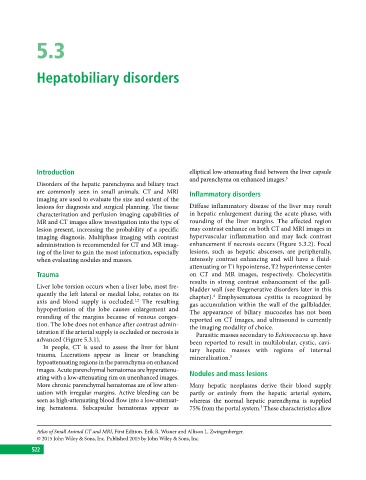Page 532 - Atlas of Small Animal CT and MRI
P. 532
5.3
Hepatobiliary disorders
Introduction elliptical low‐attenuating fluid between the liver capsule
and parenchyma on enhanced images. 3
Disorders of the hepatic parenchyma and biliary tract
are commonly seen in small animals. CT and MRI Inflammatory disorders
imaging are used to evaluate the size and extent of the
lesions for diagnosis and surgical planning. The tissue Diffuse inflammatory disease of the liver may result
characterization and perfusion imaging capabilities of in hepatic enlargement during the acute phase, with
MR and CT images allow investigation into the type of rounding of the liver margins. The affected region
lesion present, increasing the probability of a specific may contrast enhance on both CT and MRI images in
imaging diagnosis. Multiphase imaging with contrast hypervascular inflammation and may lack contrast
administration is recommended for CT and MR imag enhancement if necrosis occurs (Figure 5.3.2). Focal
ing of the liver to gain the most information, especially lesions, such as hepatic abscesses, are peripherally,
when evaluating nodules and masses. intensely contrast enhancing and will have a fluid‐
attenuating or T1 hypointense, T2 hyperintense center
Trauma on CT and MR images, respectively. Cholecystitis
results in strong contrast enhancement of the gall
Liver lobe torsion occurs when a liver lobe, most fre bladder wall (see Degenerative disorders later in this
quently the left lateral or medial lobe, rotates on its chapter). Emphysematous cystitis is recognized by
4
axis and blood supply is occluded. The resulting gas accumulation within the wall of the gallbladder.
1,2
hypoperfusion of the lobe causes enlargement and The appearance of biliary mucoceles has not been
rounding of the margins because of venous conges reported on CT images, and ultrasound is currently
tion. The lobe does not enhance after contrast admin the imaging modality of choice.
istration if the arterial supply is occluded or necrosis is Parasitic masses secondary to Echinococcus sp. have
advanced (Figure 5.3.1). been reported to result in multilobular, cystic, cavi
In people, CT is used to assess the liver for blunt tary hepatic masses with regions of internal
trauma. Lacerations appear as linear or branching mineralization. 5
hypoattenuating regions in the parenchyma on enhanced
images. Acute parenchymal hematomas are hyperattenu Nodules and mass lesions
ating with a low‐attenuating rim on unenhanced images.
More chronic parenchymal hematomas are of low atten Many hepatic neoplasms derive their blood supply
uation with irregular margins. Active bleeding can be partly or entirely from the hepatic arterial system,
seen as high‐ attenuating blood flow into a low‐attenuat whereas the normal hepatic parenchyma is supplied
ing hematoma. Subcapsular hematomas appear as 75% from the portal system. These characteristics allow
5
Atlas of Small Animal CT and MRI, First Edition. Erik R. Wisner and Allison L. Zwingenberger.
© 2015 John Wiley & Sons, Inc. Published 2015 by John Wiley & Sons, Inc.
522

